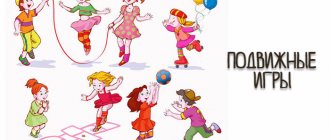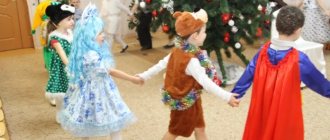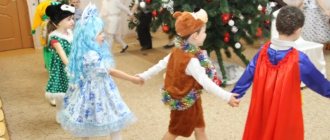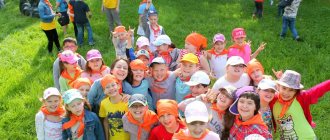Board games for home
Board games are useful for developing children's thinking, their ingenuity, training memory and attention; they cultivate perseverance and patience, the ability to think through their actions, and accept both successes and defeats. There are many types of board games: adventure games, mazes, puzzles, games with cards (lotto, memory), with bones (dominoes), figures (checkers, chess), story games and others. Before you offer your child any of these games, make sure that it is age appropriate and get him interested.
For kids, choose simple games with specific objects (rather than abstract concepts), involving a specific action (rather than a chain of actions), including in the game concepts that are already familiar to them (names of animals, toys, household items, etc.). We offer you the following options:
- “Find the same one.” Print or draw cards (2 copies each) depicting objects familiar to the child (apples, pencils, houses, etc.). Lay it out in front of him and ask him to find identical pictures.
- "What's missing." Place 5-6 familiar objects (animal figures, small toys, cards) in front of your baby. Ask them to look carefully, name each one, and then close their eyes. Discreetly remove one of the items. Let the child open his eyes and guess what is missing.
- “Where is the roof?” Cut out several squares of different colors and the same number of triangles of the same color from colored cardboard. Lay them out in front of the baby and ask them to choose a roof for each house: place a triangle of the same color over the square.
For board games with kids, sets of cards of various themes will be useful.
For children 3–4 years old, offer the following games:
- “Fold the picture.” Take a picture with a plot that the child can understand and cut it into several parts. Ask your child to put everything back as it was.
- "That more". Draw or print several images of objects familiar to your child, only in different sizes (for example, a small Christmas tree, a larger Christmas tree, a medium Christmas tree and a large Christmas tree). Ask your child to arrange the pictures from smallest to largest, then vice versa.
- "Colored Domino" Take popsicle sticks (strips of cardboard) and paint them on both sides with different colors. There can be any number of sticks, but if you apply them in the same colors to each other, as a result they should close in a circle. Before the game starts, the sticks (cardboards) are turned face down. Each player takes 6 sticks. Use a counting rhyme to determine who goes first. Players take turns placing sticks on the table, connecting them with the sides that match in color. If the player does not have a stick of a matching color in his hand, he takes them from the general pile at random until he finds the one he needs. The first one to get rid of his “colored domino” wins.
Classic dominoes have 28 dominoes
- "Tic-tac-toe." Since drawing crosses and toes on paper for children of this age is a very tedious task, prepare a playing field in advance (draw, print, make from cardboard, fleece) and 5 chips for two players (these can be, for example, large buttons, cardboard caps, acorns and chestnuts, beans and pasta, etc.). Participants in the game take turns laying out their chips, trying to line them up in one row (vertically, horizontally or diagonally). Whoever succeeded first won.
You can compose a beautiful legend for a child: ladybugs are so friendly that they want to stand together and not part, or something similar
Board games for older preschoolers teach them to focus on one thing for a long period of time, develop logic, memory, attention, and thinking. Offer the following options to children ages 5–7:
- "Checkers". You can buy this game, or you can make it yourself by printing out the playing field and using buttons of two colors, bottle caps, cardboard figures, acorns and chestnuts, etc. instead of checkers.
Checkers are easy to make from scrap materials
- "Repeat". Prepare two identical sets of multi-colored buttons or cardboard cutouts. Players take turns placing buttons or figures in front of them in a certain sequence, giving the opponent some time to memorize the composition. Then they cover this composition with a sheet of cardboard and ask the second participant to arrange the buttons (shapes) in the same order. Points are awarded for the correct answer. Whoever gets the most points in the end wins.
- "Fleas." Take a cardboard candy box with high sides. Divide it into two parts. pasting it with colored paper or painting it. Draw a “soccer goal” on each half. Prepare “players” for each participant (white and colored beans, buttons of two colors) and a coin. Participants take turns, trying to use a coin to press the bean so that it (“like a flea”) hits the opponent’s goal. The one who hits is given a point and the “flea” that reached the target is removed from the field. If a player does not hit the goal, but reaches the opponent’s field, the “flea” is removed, but the point is not counted. If a bean lands on its own field, it is not removed and the point is not counted. If the flea hits its own goal, the point is awarded to the opponent. They play until one of the participants runs out of “players.” The one with the most points wins.
This gambling game will appeal to both preschoolers and older players
Schoolchildren are able to independently organize their pastime. Give them some ideas:
- "From general to specific". Give the children a set of cards in which they will need to arrange these cards according to concepts from the more specific to the more general (jaguar, animal, cat family; raspberry, bush, berry; cucumber, plant, vegetable; snowflake, snow, natural phenomenon). When the guys grasp the essence of the game, invite them to come up with variations of cards for their friends.
- “Put it right.” The game can be played by one child or a group of children. Give them some small chips, symbolic mugs (corks, chestnuts). Next, place one of the chips in the middle of the table and ask the child to place another chip on top (left, right, bottom) of it. If there are several participants, then give the teams in turns. The presenter can think in advance of some kind of figure that is formed as a result of the chips correctly placed by the children (car, dog, star).
- "Field of Knowledge". To play the game you will need a short text or story, blank pieces of paper and pens according to the number of players. One of the participants reads the text. Then everyone writes questions on sheets of paper designed to clarify details in this text (the questions should be difficult). The notes are laid out face down and shuffled. Players take turns taking pieces of paper from the table (from the “Knowledge Field”) and coming up with original answers to the questions.
Word games for home
Verbal games are aimed at developing a child’s speech, replenishing his vocabulary, developing correct sound pronunciation, developing the ability to express his opinion, draw conclusions, and apply new knowledge in various situations.
For the little ones, this game is suitable:
“Whoever says what.” For the game, prepare pictures depicting objects familiar to the child, for which you can select onomatopoeia (car - beep, steam locomotive - tu-tu, dog - woof-woof, etc.). Show the cards and say what is written on them. Then ask your child to pronounce the onomatopoeia himself.
For older kids, choose a different game option. Throw the ball to the child, naming the animal, and the child, having caught the ball, let him answer as the animal says.
To make speech games interesting, use balls, balloons, flags, chips
Children three to four years old already have basic understanding of the world around them and can construct simple sentences. Expand their language skills with these word games:
- "It's the other way around." An adult throws a ball to a child, says a word, to which you need to choose another word with the opposite meaning: day - night, cold - hot, dry - wet, etc. The child, having caught the ball, selects the right word.
- "Confusion". The adult tells the child sentences, deliberately making mistakes in them (“Mom washed the dishes”, “The boy ate the soup”, “There are curtains hanging on the windows”). The baby must notice them and correct them.
- "Conventional signs". The game can be played with one child or with several. Before starting the game, participants agree on a symbol for affirmative and negative answers (for example, “yes” is clapping your hands, “no” is stamping your foot). The adult shows cards with images of objects familiar to the children and says what is drawn on them, sometimes deliberately pronouncing the words incorrectly (instead of “tram” he says “tranvay”, instead of “house” - “donik”). Children use conventional signs to show agreement or disagreement with this pronunciation.
- "Broken phone". The game requires the participation of several children. Boys and girls sit in a row. An adult whispers a simple word understandable to the children in the first player's ear so that others do not hear. He passes the word to another, also in a whisper. The last player says the word he heard out loud.
The game “Broken Phone” is relevant at any age
Children five to seven years old are able to express their thoughts and construct logical sentences. Games with words teach them to speak freely, choose the right words and word forms:
- "Catch the ball." The game can be played individually with the child or with a group. For this you will need a ball (balloon). The adult names the noun and throws the ball to the child. He must catch the ball and name the adjective formed from this word: winter - winter, rain - rainy, tree - wooden, etc.
- "Cities". A variant of the game for preschoolers assumes that one of the participants in the game names a word, and the next one must name another word that begins with the letter with which the previous one ended (koT-TopoR-Rot). Older children come up with names of cities. Words should not be repeated. If a word ends with a letter that the word cannot begin with, then they come up with a word starting with the previous letter.
- "Let's make up a fairy tale." The game requires several participants. The first player comes up with the beginning of a fairy tale (one sentence). The next one adds his own. So all the participants in the chain come up with an interesting story.
Collective imagination is sometimes capable of creating the most incredible and funny stories
Schoolchildren need speech games to develop creative and communication abilities, train logic, thinking and memory. Offer them the following options:
- "What if." The participants in the game ask each other questions and assumptions: “What would happen if ...” (people could fly, a person would not need sleep, if going to school was not necessary, etc.). Answers must be detailed and original.
- "Make words." On a large piece of paper (on the board) you need to write a long word (car, power plant, rock climber). Participants in the game need to create new words from the letters of this word. The winner is the one who comes up with the most new words.
- "Stupid suggestions." The game requires at least two participants. One comes up with a word, and the second composes a sentence in which each word begins with the letters of the word that the first participant named. For example, the word “house” deciphers as “a friend gave a hammer.”
- "Associations". The presenter leaves the room, and the rest of the participants guess the name of any player. The presenter’s task is to guess this person by asking association questions, for example: “What bird does this person look like: a magpie, a sparrow or an eagle?”, “If this person were an animal, would it be a wolf, a bull or a fox?”
Games for the house will come in handy during children's parties
Video: word games for children
Coloring pages
Do you want to draw, but with benefit, and at the same time motivate to learn? Use our coloring pages! They are given as a reward for correct answers, and the stories in them help to get acquainted with new topics: children's holidays, seasons and situations familiar to the child, which can then be used to create a fairy tale. Collect coloring books from Ikyusha in a separate folder and turn them into a picture book.
Role-playing games for home
Role-playing games teach children to communicate, negotiate, behave correctly in various everyday situations, and enrich their knowledge about the world around them.
The following games are the most popular among children:
- "Shop";
- “Mothers and Daughters”, “Family”;
- “Hospital”, “At the doctor’s appointment”;
- "Police";
- “Kindergarten”, “School”;
- "Builders";
- "Firefighters";
- “Cook”, “Cafe”, “At Lunch”;
- "Zoo", "Farm";
- “At the Circus”, “Theater”, “At the Concert”;
- “Cosmonauts”, “Seafarers”, “Travelers”;
- "Salon";
- “Auto racing”, “Rules of traffic”.
Role-playing fun helps children “play out” various everyday situations
Elements of role-playing games are present in the play of children as young as two years old (putting a bear to sleep, hammering nails with a toy hammer, “like daddy,” etc.). In early preschool age, a child learns to perform a sequence of actions (bring toys one by one to the doctor; select goods, then put them in a basket and pay for them at the checkout).
Puzzles
Something that all kids love! With and without rhyme, about animals and letters, about logic and intelligence - this is a favorite educational game for children of all ages. All our riddles not only entertain, but also educate and test knowledge. Each task has an illustration and explanation of the correct answer, so that the child learns to think and crack riddles like nuts.
Musical games for home
Musical games develop musical taste, creativity, emotional sensitivity, and teach you to distinguish the tempo and character of a musical piece.
The following game options are suitable for the little ones:
- "What's the sound". Invite your child to listen to the sound of a drum, a rattle, a tambourine (a closed box of beans or peas, a spoon in a bowl, a bell - anything that can sound). Then ask him to close his eyes and guess what will sound now. Play a sound familiar to your baby. If the baby still cannot name what it sounded, let him point to this object.
- "Do as I do". Play children's funny dance tunes and invite your child to repeat the movements after you.
- "Listen carefully". Invite your baby to listen in silence to the sounds that come from everywhere. What will he hear? Maybe like a neighbor banging a hammer, the wind humming outside the window, a cat meowing behind the wall, the clock ticking in the room, soup being cooked in a pan?
I love to organize “discos” with my children. I don’t even need to ask the children to repeat the movements after me, they do it anyway. Over time, at the sound of music, the kids themselves begin to dance, without even seeing the example of an adult, but amusingly repeating the movements that they once learned with him (spinning, making “flashlights,” waving their arms above their heads, moving their necks, stamping their feet, twirling around myself).
Love and interest in music is instilled from childhood
The following games are suitable for children 3–4 years old:
- "Guess the song." Sing or play, if you know how, songs familiar to your child. Let him remember their names.
- “Continue the song.” Sing a song known to your baby, but suddenly pause, he must continue it.
- "Music of stops." Play a children's song or sing (play) it yourself. Children should dance to it, inventing various movements themselves. Warn the children (the more players, the more fun the game, but you can play with one child) that as soon as the music stops, they will have to sit down immediately (on the carpet, on a chair). Then the music continues to play and the children move again.
- "Learning notes." Take a sheet of music and show your child how to draw notes (to start, take three notes, for example, C, D and E, and draw them as dots on the music lines). Then prepare two chips (buttons, chestnuts), one for yourself, the second for the child. Place them side by side. Show your child the drawn notes. If he remembers their name correctly, he moves his chip forward, if incorrectly, you move yours.
Children who are planning to get involved in playing a musical instrument in the future need to get acquainted with the names of notes.
For older preschool children, offer the following activities:
- "Let's play!" Keys are required to play. Show your child what sounds will be made if you press the keys. Tell him to turn away, press one of the keys, then ask him to find this sound himself by pressing the desired key (to begin with, limit the number of keys to guess to 3-4).
- “Clap like me!” Give your child some rhythm. Let him repeat after you. At first, use easy melodies (clap twice quickly, once slowly), and over time, complicate the task.
- "Who is first". A game for several participants. You play the melody of a famous song, and the children - whoever is faster - must remember it and sing it.
- "Show me." The children stand in a circle, and one of the players, the children, leads a round dance and sings to any tune: “Show me, show me how sparrows jump” (“old men walk”, “bears stomp”, “dogs run”, “hares jump” ). The one in the center depicts the required movement, then another “artist” is chosen.
The main thing is that children try not to shout the words of the songs, but hear the music, trying to hit the right tone
For schoolchildren, the games become more complicated:
- "Message to the Tribes" One of the participants comes up with a message to the “neighboring tribe” and voices it (“come visit us”, “it’s raining today”, etc.), and then taps the rhythm of this message on a drum. The other participant must repeat the “message on the drum” exactly. Then the roles change.
- “Come up with a movement.” To the accompaniment of diverse music (smooth, cheerful, fiery, sad), one of the participants comes up with characteristic movements, and the others must repeat them. Then another child is chosen to play the role of “choreographer”.
- “Make a melody.” Keys are required to play. Ask your child to pretend that rain is dripping (knock on the keys with a high sound), a bear is stomping (play on the lower ones), a bunny is sad (slowly touch the keys), children are running (play quickly).
Outdoor games for home
The physical health of children is unthinkable without movement. But it is not always possible to run outside (for example, when it rains). Safe outdoor games can be organized at home.
Suitable for kids:
- "Catching up." Of course, older children won’t be able to play this game in a standard apartment, but for kids it’s just the thing. Even those who cannot walk love to crawl on all fours from their parents and older brothers and sisters. And they love it even more when someone finally catches up with them, giving them a gentle kiss and hugging them.
- "Tunnel". Place stools at some distance from each other and cover them with a blanket so that a tunnel is formed. Invite the baby to crawl over it, and you yourself joyfully meet him at the entrance.
- "On the bumps." Place colored sheets of cardboard or pieces of fabric on the floor at such a distance that the baby can jump from one “bump” to another. Tell him that he needs to move over these “bumps” so as not to fall into the “swamp”.
- "Fun Obstacles" Place pins (or other small objects) close to each other to create a labyrinth. Invite your child to run between the pins so that they do not fall.
Tunnels and labyrinths for outdoor games can be built from pillows, chairs, blankets and other available materials
The following activities are suitable for children aged 3–4 years:
- “Catching up with houses.” Lay out circles of hoops (ribbons, straps) or place stools around the house, explaining to the child that these are “houses.” You can hide in them when they catch up with you. One of the players catches up with the other (others) while he is not in the house. When he praised the one who was escaping, they switch roles.
- “Feet higher off the ground.” This game is similar to the previous one, only you can’t show off when the player sits on something and lifts his feet off the ground.
- "Blind Man's Bluff." One of the participants is blindfolded with a scarf and he tries to catch other children who are hanging around at this time and teasing him (voicing). It is important that the game is played in a strictly defined area, and that players do not scatter to other rooms, otherwise the game may become unsafe.
- "Snowballs." Crumple up “snowballs” from sheets of white paper and start a battle.
Monitor the safety of children during outdoor games: remove dangerous objects from their path, limit the area for games
For children aged 5 to 7 years old, offer the following activities:
- "Hide and seek." There are two versions of the game - either one of the players or an object can hide. The task of the rest is to detect the loss, after which the roles change. If an object was hidden, then someone who knows its location can comment on the actions with the words “hot” (object close), “cold” (far), “hotter” (closer), “colder” (further).
- "Edible - inedible." Children sit in a circle and throw a ball to each other, naming various objects and foods. If the named word is “edible”, the one to whom the ball flies must catch it (“eat”). If it’s inedible, quickly discard it.
- "Pig". Children stand in a circle and, to the music, pass a ball or a soft toy to each other, trying not to drop it (it) and pass it as quickly as possible. Suddenly the music stops. Whoever happened to have a toy at that moment should say loudly: “Oink-oink!”
- "Two" and "three". You will need a group of children to play. The presenter calls the number (one, two, three), and the players are grouped according to this number (they stand in twos, threes). The one who does not have time is eliminated from the game.
There are many options for playing hide and seek for children of different ages.
Schoolchildren will enjoy the following games:
- “Right on target!” Place a bucket and give the children a ball. Let them throw it in the bucket. Whoever hits the target gets a point. Gradually you can move the bucket further and further.
- "Balloon Race" You will need balloons according to the number of participants. Players must move their balls from one room to another without touching them with their hands (you can blow, push with your chin, elbows, heels, etc.).
- "Confusion". The game is suitable for a fun company. A presenter is selected and leaves the room for a while. The rest of the children hold hands and try to get entangled without opening their hands (someone crawls between the other two children). The presenter’s task is to untangle the guys without opening their hands.
- "Web". Take a skein of thick, strong knitting thread. Attach (tie, tape) one end low somewhere in the room. When unwinding the yarn, fasten it in different places. The child should not see your preparations. Then give the end of the thread to the child and ask him to wind it back into a skein.
- "The hat fell." Place light books or folders on the children's heads. They must move with them so that they do not fall. Whoever's “hat” lasts longer wins.
Not everyone can untangle such a web.
ABC
What does the letter A look like? How many words starting with this letter can you find around? Online alphabet and educational games for learning the alphabet will help with this! We have come up with 33 colorful and brightly illustrated exercises for each letter that will help your child name, distinguish visually and auditorily, as well as pronounce and read letters. Our alphabet course is the first step to reading, which will turn the learning process into an exciting quest.









